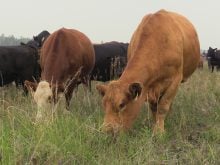This cattle market information is selected from the weekly report from Canfax, a division of the Canadian Cattlemen’s Association. More market information, analysis and statistics are available by becoming a Canfax subscriber by calling 403-275-5110 or at www.canfax.ca.
Heifers finish strong
Alberta heifers had an exceptionally strong week, closing up $8.01 and a record $270.61 per hundredweight Jan. 17.
Read Also

No special crop fireworks expected
farmers should not expect fireworks in the special crops market due to ample supplies.
Steers also climbed $2.46 to finish at $269.26 for the week.
The Alberta cash-to-futures basis remained weak, however, at -$14.07 per cwt. This is the third weakest basis in the last 10 years for the same week; only 2023 and 2024 were weaker.
Dressed sales were also stronger, up $2-$4 to $437-$442 per cwt.
All three western Canadian packers participated in the market, and cattle were scheduled for immediate to mid-February delivery.
U.S. sales earned premiums over local markets in the low to mid $270s per cwt.
Ontario recorded light trade with dressed sales at $445 per cwt. delivered, steady with the previous week.
The Ontario cash-to-futures basis was -$17.27 per cwt., weaker than the five-year average of $8.28.
While January is typically the weakest month of the year for the fed market, that isn’t the case so far. However, the possibility of tariffs presents downside risk.
In the United States, live sales in Texas and Kansas were steady at $200-$201 per cwt., while in northern feeding states, they ranged from $203-$205, steady to $2 per cwt. stronger than the previous week.
Dressed sales were mostly about $2 per cwt. stronger at $322.
U.S. cow slaughter was down 16 percent year over year for the first week in January, and fed slaughter was down four percent. Steer carcass weights were 959 pounds, one lb. shy of 2024’s record high.
Corn futures rallied 14 cents per bushel over the week and are 28 cents per bu. higher since the U.S. Department of Agriculture reported a smaller 2024 corn crop.
Cow slaughter down
Volumes of slaughter cows and bulls through auctions have been manageable, but there is a large volume of grain-fed cows on the market. There is little to no premium paid for these cows, and the market is underperforming relative to the fed market. Cow prices typically strengthen from January through spring. The market is working through ample first half supplies because volumes usually peak in early February.
Alberta cow prices averaged in the mid-$180s per cwt., about $4 higher than the previous week. They are trading at a $5 per cwt. premium against the U.S. and are expected to challenge highs set in June 2024 of $195 per cwt.
Canfax said cow marketings are poised to end 2024 smaller than 2023 and the smallest on record going back to 1998, except for 2003 and 2004.
Federally inspected cow slaughter was 405,000 head, down 20 per cent from 2023 and 13 per cent from the five-year average.
Beginning 2025, cow slaughter is down 9.2 percent. Cow exports are also down, putting total cow marketings at about 574,000 head. The last time cow marketing dropped below 600,000 head was in 2015.
The beef cow culling rate for 2024 is estimated at 10.8 per cent. A rate of 11-12 percent suggests liquidation, while a lower rate points to expansion. Statistics Canada will release its inventory report at the end of March and that will indicate whether the herd has stabilized.
Feedlot demand strong
Calf and feeder volumes to mid-January have been historically large thanks to decent temperatures, record prices and the threat of possible U.S. tariffs.
Feedlot demand remains strong and eastern Canadian buyers have been active on 700 to 1,000 lb. steers.
The largest price increase has been on calves and lightweight stockers, at $30-$55 per cwt. hikes. In some cases, six-weights brought the same as 850 lb. steers. Strength in the calf market is coming from strong forward delivery prices for cattle coming off grass.
Alberta and Saskatchewan steers weighing 950 to 1,000 lb. for late summer/early fall delivery traded in the low $360s, up $20 compared to the previous month.
Fed cattle price insurance was up to $272 per cwt., covering May to early June, and is the highest coverage on record.
Cut-out spread narrows
U.S. Choice cut-out values were up about $3 per cwt. to $333.41, but Select values were up 3.6 percent, or $11, to $319.38 per cwt.
The spread between the two continues to narrow, and at $14 was between last year and the five-year average.














